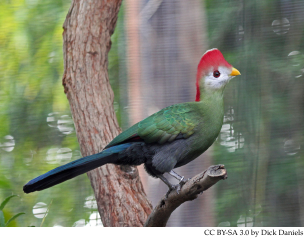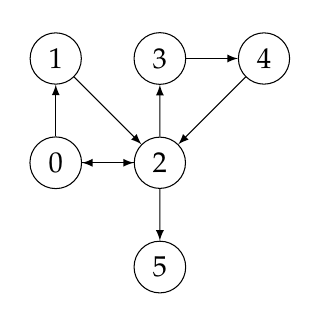
Kiara does not know the real graph $$$\mathcal{G}$$$ governing the flight of these birds but, in her previous field study, Kiara has collected data from the journey of many birds. Using this, she has devised a graph $$$\mathcal{P}$$$ explaining how they move. Kiara has spent so much time watching them that she is confident that if a bird can fly directly from $$$a$$$ to $$$b$$$, then she has witnessed at least one such occurrence. However, it is possible that a bird flew from $$$a$$$ to $$$b$$$ to $$$c$$$ but she only witnessed the stops $$$a$$$ and $$$c$$$ and then added $$$( a, c )$$$ to $$$\mathcal{P}$$$. It is also possible that a bird flew from $$$a$$$ to $$$b$$$ to $$$c$$$ to $$$d$$$ and she only witnessed $$$a$$$ and $$$d$$$, and added $$$(a, d)$$$ to $$$\mathcal{P}$$$ , etc. To sum up, she knows that $$$\mathcal{P}$$$ contains all the edges of $$$\mathcal{G}$$$ and that $$$\mathcal{P}$$$ might contain some other edges $$$(a, b)$$$ for which there is a path from $$$a$$$ to $$$b$$$ in $$$\mathcal{G}$$$ (note that $$$\mathcal{P}$$$ might not contain all such edges).
For her next field study, Kiara has decided to install her base next to a given tree $$$T$$$. To be warned of the arrival of birds on $$$T$$$, she would also like to install detectors on the trees where the birds can come from (i.e. the trees $$$T'$$$ such that there is an edge ( $$$T', T$$$) in $$$\mathcal{G}$$$ ). As detectors are not cheap, she only wants to install detectors on the trees $$$T'$$$ for which she is sure that $$$( T', T)$$$ belongs to $$$\mathcal{G}$$$.
Kiara is sure that an edge $$$(a, b)$$$ belongs to $$$\mathcal{G}$$$ when $$$(a, b)$$$ is an edge of $$$\mathcal{P}$$$ and all the paths in $$$\mathcal{P}$$$ starting from $$$a$$$ and ending in $$$b$$$ use the edge $$$(a, b)$$$. Kiara asks you to compute the set $$$S( T )$$$ of trees $$$T'$$$ for which she is sure that $$$(T', T)$$$ is an edge of $$$\mathcal{G}$$$.
The input describes the graph $$$\mathcal{P}$$$. The first line contains three space-separated integers $$$N$$$, $$$M$$$, and $$$T$$$: $$$N$$$ is the number of nodes of $$$\mathcal{P}$$$, $$$M$$$ is the number of edges of $$$P$$$ and $$$T$$$ is the node corresponding to the tree on which Kiara will install her base.
The next $$$M$$$ lines describe the edges of the graph $$$\mathcal{P}$$$. Each contains two space-separated integers $$$a$$$ and $$$b$$$ ($$$0 \le a$$$, $$$b < N$$$ and $$$a \ne b$$$) stating that $$$(a, b) \in \mathcal{P}$$$ . It is guaranteed that the same pair $$$( a, b)$$$ will not appear twice.
Limits
Your output should describe the set $$$S(T)$$$. The first line should contain an integer $$$L$$$, which is the number of nodes in $$$S(T)$$$, followed by $$$L$$$ lines, each containing a different element of $$$S(T)$$$. The elements of $$$S(T)$$$ should be printed in increasing order, with one element per line.
3 3 2 0 1 0 2 1 2
1 1
6 8 2 0 1 0 2 1 2 2 0 2 3 3 4 4 2 2 5
2 1 4
Sample Explanation 1
The graph corresponding to this example is depicted below. The node 1 belongs to $$$S(2)$$$ because the (only) path from 1 to 2 uses (1, 2). The node 0 does not belong to $$$S(2)$$$ because the path $$$0 \to 1 \to 2$$$ does not use the edge (0, 2).

Sample Explanation 2
The graph corresponding to this example is depicted below. For the same reason as in Sample 1, the node 0 does not belong to $$$S(2)$$$ while 1 does. The nodes 3 and 5 do not belong to $$$S(2)$$$ because we do not have edges (3, 2) or (5, 2). Finally 4 belongs to $$$S(2)$$$ because all paths from 4 to 2 use the edge (4, 2).
